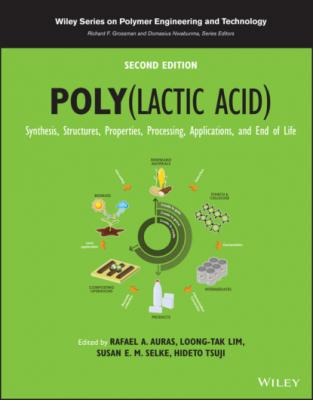Poly(lactic acid). Группа авторов
Чтение книги онлайн.
Читать онлайн книгу Poly(lactic acid) - Группа авторов страница 70

Furthermore, stereocomplexation involving alternating copolymers comprising lactic acid (LA) units have been studied extensively. For example, blending of enantiomeric alternating copolymer of LA and glycolic acid (GA) having molecular weight of 5000 Da leads to preferential formation of stereocomplex crystallites as reported by Tsuji et al. [68]. They proposed that blending of alternating LA‐based copolymers could be a versatile technique for the development of high‐performance bio‐based biodegradable materials with tunable physical properties and biodegradability. Yet another study reports the incorporation of alanine unit into LA units in random copoly(ester‐amides) with ester and amide linkages leading to the preferential formation of sc crystallites [69]. However, the developed polymers contain low degree of polymerization, and to have them employed in the commercial scale utility, further development is needed.
5.5.2 sc‐PLA–PCL Copolymers
Lately, there have been important advances in sc blends of PLA copolymers for biomedical implant applications. In a study reported by us [70], diblock copolymers of PCL‐PLLA and PCL‐PDLA were synthesized by two‐step ROP followed by blending them in a 1 : 1 ratio to achieve sc blends of the enantiomeric diblock copolymers. Using this strategy, it was possible to obtain enantiomeric diblock copolymers having enhanced mechanical properties (28 MPa strength and ~80% elongation at break), which were also processed by the conventional injection moulding technique to develop cancellous bone screws (orthopedic implants). The study reported the thermomechanical stability of the cancellous bone screw at 121°C in comparison to commercial PLA (2003D, NatureWorks LLC). The stereococomplexed diblock copolymer was found to be stable at the sterilization temperature of biomedical devices, unlike the commercial PLA sample. The biocompatibility of the synthesized sc diblock copolymer blend was also ascertained by MTT (3‐(4,5‐dimethylthiazol‐2‐yl)‐2,5‐diphenyl tetrazolium bromide) assay using MG‐63 cells (human bone osteosarcoma). In another study reported by our group, the triblock copolymers of PLLA‐PCL‐PLLA and PDLA‐PCL‐PDLA were synthesized by sequential ROP, where the block length of the terminal as well the mid segment was tailored. The enantiomeric triblock copolymers were blended in equal ratios to achieve the sc blends of triblock copolymers. Such blends of triblock copolymers resulted in a significant improvement in the elongation at break (~400 ‐ 700%) as well as Young’s modulus (0.3 ‐ 0.9 GPa), with a very low degree of sc crystallinity. The adhesion and growth of UMR‐106 cells (rat bone osteosarcoma) on the surface of the developed sc triblock copolymer further indicated its non‐toxic nature. [100].
5.5.3 sc‐PLA–PEG Copolymers
Polyethylene glycol, being hydrophilic in nature, leads to the development of amphiphilic materials when used in combination with hydrophobic polymers [71, 72]. Amphiphilic copolymers based on PLA [73] have received attention in several applications including pharmaceutical, drug delivery [74, 75], hydrogels for tissue engineering [76], and so on. The aqueous self‐assembly of amphiphilic PEG‐sc‐PLA copolymers has been reported by Noack et al. [77] where the block copolymers PEG–PLLA and PEG–PDLA were synthesized by ROP using polyethylene glycol monomethyl ether (PEG–OH) as a macroinitiator for the enantiomeric polymer blending. In these sc‐block copolymers, the decreasing hydrophobic unit (lactide) content led to the increased formation of worm‐like aggregates at ambient conditions. The preferential formation of spherical micelles was observed for the most related block copolymers (as revealed from the dynamic light scattering analysis), which became colloidally unstable upon increasing the crystalline PLA, leading to the formation of worm‐like aggregates [77]. Bio‐functional injectable hydrogels based on PEG‐sc‐PLA were reported by Wang et al. for cartilage tissue engineering [78]. The ROP of D‐ and L‐lactides was performed using four‐arm PEG as a macroinitiator to develop four‐arm PEG‐PDLA and PEG‐PLLA copolymers, respectively. This was followed by synthesizing their cholesterol (Chol)‐modified derivatives, namely four‐arm PEG‐PDLA‐Chol and four‐arm PEG‐PLLA‐Chol, by condensation reaction. The sc blends of the both enantiomers resulted in the stereocomplexes, scPLA (four‐arm‐PEG‐PLA) and scPLA‐Chol (four‐arm PEG‐PLA‐Chol), which were employed as 3D scaffolds for cartilage tissue engineering. The cholesterol‐modified sc‐PLA‐Chol had a higher critical gelation temperature, improved mechanical properties, better adhesion to chondrocytes, and slower degradation than the non‐cholesterol‐modified derivatives, which served as an appropriate material for cartilage regeneration. The thermal and mechanical properties of the sc‐PLA‐based copolymers and composites are reported in Table 5.3.
TABLE 5.3 Thermal and Mechanical Properties Reported for the sc‐PLA‐Based Copolymers and Composites
| Mulchandani et al. [70] | Mulchandani et al. [100] | Noack et al. [77] | Sun et al. [79] | Gupta et al. [80] | Gupta et al. [81] | Gupta et al. [82] | |
|---|---|---|---|---|---|---|---|
| Copolymer/composite | sc‐PLA/PCL | sc‐PLA/PCL | sc‐PLA/PEG | sc‐PLA/GO | sc‐PLA/chitosan | sc‐PLA/CMC | sc‐PLA/n‐HAP |
| T m,hc (°C) | 171–177 | 167–173 | — | 150 | — | 152–180 | 152–178 |
| T m,sc (°C) | 210–235 | 218–222 | 140–200 | 210 | 192–208 | 211 | 210 |
| ΔH m,hc (J/g) | 10–23 | 3.9–27.7 | — | — | — | — | 0–28 |